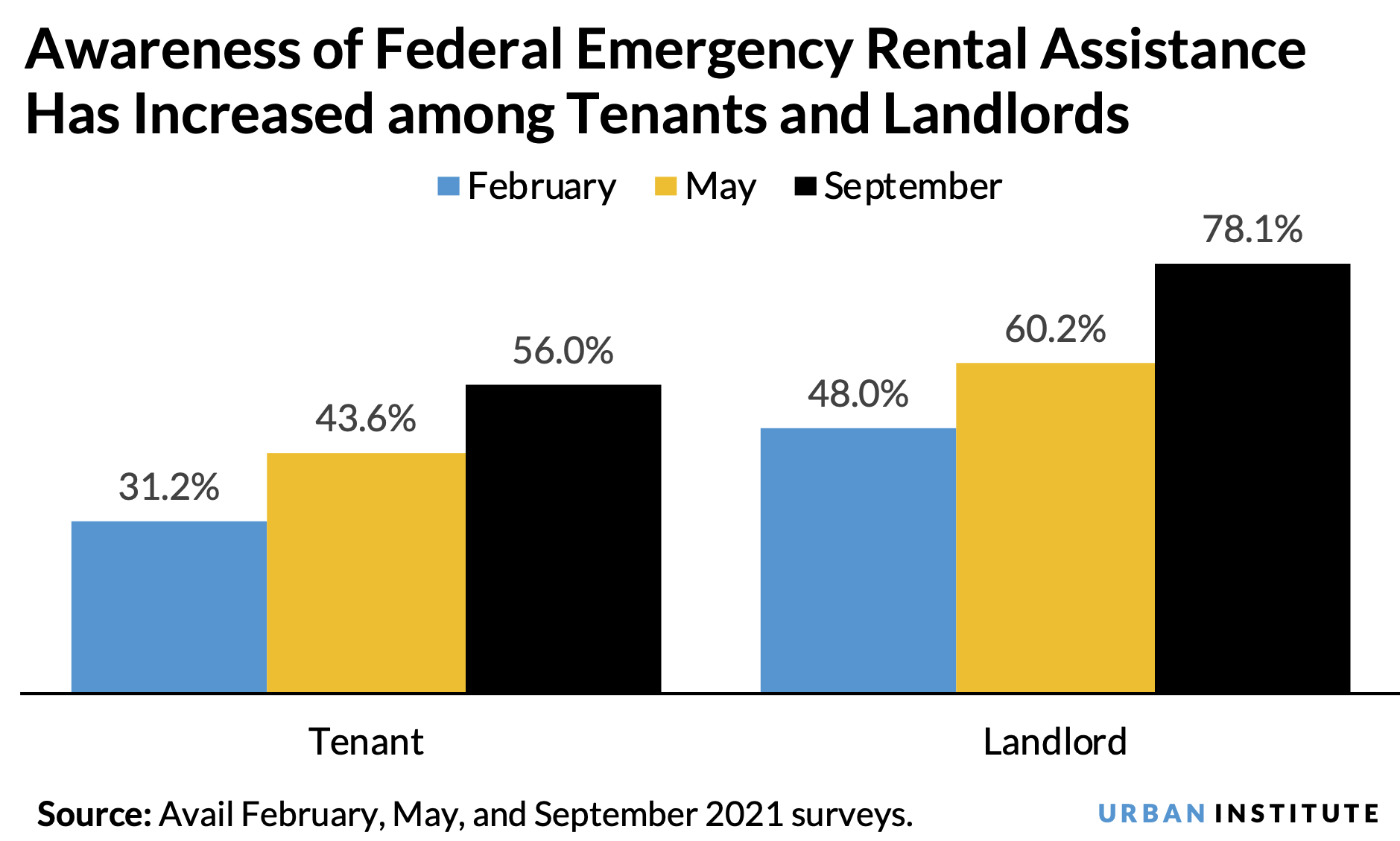
<p>(karelnoppe/Getty Images)<br />
</p>
Awareness of federal Emergency Rental Assistance (ERA)—which covers back rent, future rent, utility arrearages, future utility costs, and other expenses incurred as a result of the pandemic—has grown dramatically with the slow but steady increase of fund allocation. Despite this, many landlords and tenants are still unsure of whether they qualify, and they are not applying—which means people who need assistance still aren’t getting it.
We have been partnering with Avail, an online platform that serves mom-and-pop landlords, to understand the barriers landlords and tenants are experiencing when trying to access ERA. Recently, we analyzed the September survey results to explore the factors that influence ERA applications.
Now that the federal eviction moratorium has ended, some landlords are starting to consider evicting overdue tenants. Additional outreach to landlords and tenants is urgently needed and should focus on what the assistance covers and who is eligible to apply.
How many people are aware of ERA?
In the February 2021 survey, we found just over 30 percent of tenants and 48 percent of landlords were aware of the ERA. This number increased in the May survey, and we saw an even larger jump in the September survey (particularly among landlords), with 78 percent now aware of the assistance.

In the September survey, both tenants and landlords indicated they had heard about the assistance from a variety of sources, with word of mouth being the most common response (36 percent of landlords and 45 percent of tenants). The ramp-up of ERA distributions in recent months, after a slow start, has likely contributed to this increased awareness. State and local governments, as well as the federal government, have also increased outreach; a quarter of the landlords and tenants mentioned learning about ERA from those sources.
Many landlords and tenants are still confused about ERA
Awareness that ERA exists has not translated into applications. Both tenants and landlords expressed confusion about what it covers and whether they are eligible for the funds. Fifty-six percent of tenants and 50 percent of landlords said they did not know what the program covered. And only 29 percent of tenants and 25 percent of landlords knew utilities could be covered. Moreover, 63 percent of tenants and 57 percent of landlords were confused about whether they were eligible to apply for the funds.
The good news is that of those who understood the eligibility criteria, most applied (72 percent of landlords and 80 percent of tenants), and the overwhelming majority were able to complete the application (84 percent of tenants and 89 percent of landlords).
How the landlord-tenant relationship influences applications
The Avail survey asks several questions about the nature of landlord-tenant relationships, and we found the nature of these relationships made a critical difference in ERA application.
For tenants who completed the application and were “very satisfied” with their relationship with their landlord, only 2 percent found the application “very difficult.” In contrast, for those who were “very dissatisfied” with their landlords, 30 percent said it was “very difficult” to apply.
Among landlords who were unable to complete the application or did not apply, lack of landlord-tenant communication was the biggest factor. And among landlords who attempted to apply but did not complete the application, 70 percent said their tenant would not help complete the application.
Of landlords who did not apply, communicating with tenants was the most common reason cited, with 61 percent of landlords indicating issues in communicating with their tenants who had missed their rent. Communication was also a significant factor for tenants who did not apply, but it was less important than on the landlord side (about 22 percent of responses).
Landlords with better tenant relationships are less likely to evict
The federal eviction moratorium was no longer in place as of late August; we wanted to use the September survey to probe how likely landlords were to evict tenants who were behind on rent. Landlords were “very satisfied” with 63 percent of their tenants who were caught up on rent but were only “very satisfied” with 23 percent of those who were behind.

Among landlords with tenants who missed rent, 54 percent have considered eviction, but this consideration varied sharply depending on the relationship between the landlord and tenant. Among landlords who were “very satisfied”with the relationship, only 27 percent considered eviction. The percentages rose as the level of landlord satisfaction declined. Of landlords who were “very dissatisfied” with the relationship, 69 percent considered eviction.
We found ERA can make a big difference in limiting evictions in the wake of the end of the moratorium. In response to the question, “If you are considering evicting a tenant for non-payment of rent in the next month, would receipt of ERA for all back rent change your mind?” 70 percent of landlords with tenants who missed payments said yes.
But the percentage for whom ERA would suffice varies sharply by the quality of the landlord-tenant relationship. For landlords who were “very dissatisfied” with the relationship, only 45 percent said they would continue renting to the tenant if ERA covered the full back rent. This, in turn, likely influences whether a landlord applies for ERA in the first place. Landlords who are “very dissatisfied” with their tenants are less likely to apply for ERA because once they receive assistance, they can’t evict tenants for a period of time (PDF).
Greater outreach and a streamlined ERA application process could help tenants stay housed
Although the increase in ERA awareness is positive, a significant minority of landlords and tenants are still unaware of the program. Our analysis underscores that outreach efforts need to continue and should be more detailed and targeted to ensure landlords and tenants understand their eligibility and how to apply.
It also illustrates that landlord-tenant relationships are a key determinant of whether applications are completed. The current ERA1 guidelines (PDF) allow for assistance to renters when landlords won’t cooperate, and ERA2 requires it (PDF), but these provisions are not well understood. To address this, a more streamlined application process could be considered in which the landlord-tenant relationship is less influential.
Given the number of tenants at risk of eviction, it is critical not only to continue increasing awareness of ERA funds but to speed up distribution. The survey results clearly show that most landlords would keep their tenants if the back rents were made up.
The Urban Institute has the evidence to show what it will take to create a society where everyone has a fair shot at achieving their vision of success.
Let’s build a future where everyone, everywhere has the opportunity and power to thrive
Urban is more determined than ever to partner with changemakers to unlock opportunities that give people across the country a fair shot at reaching their fullest potential. Invest in Urban to power this type of work.